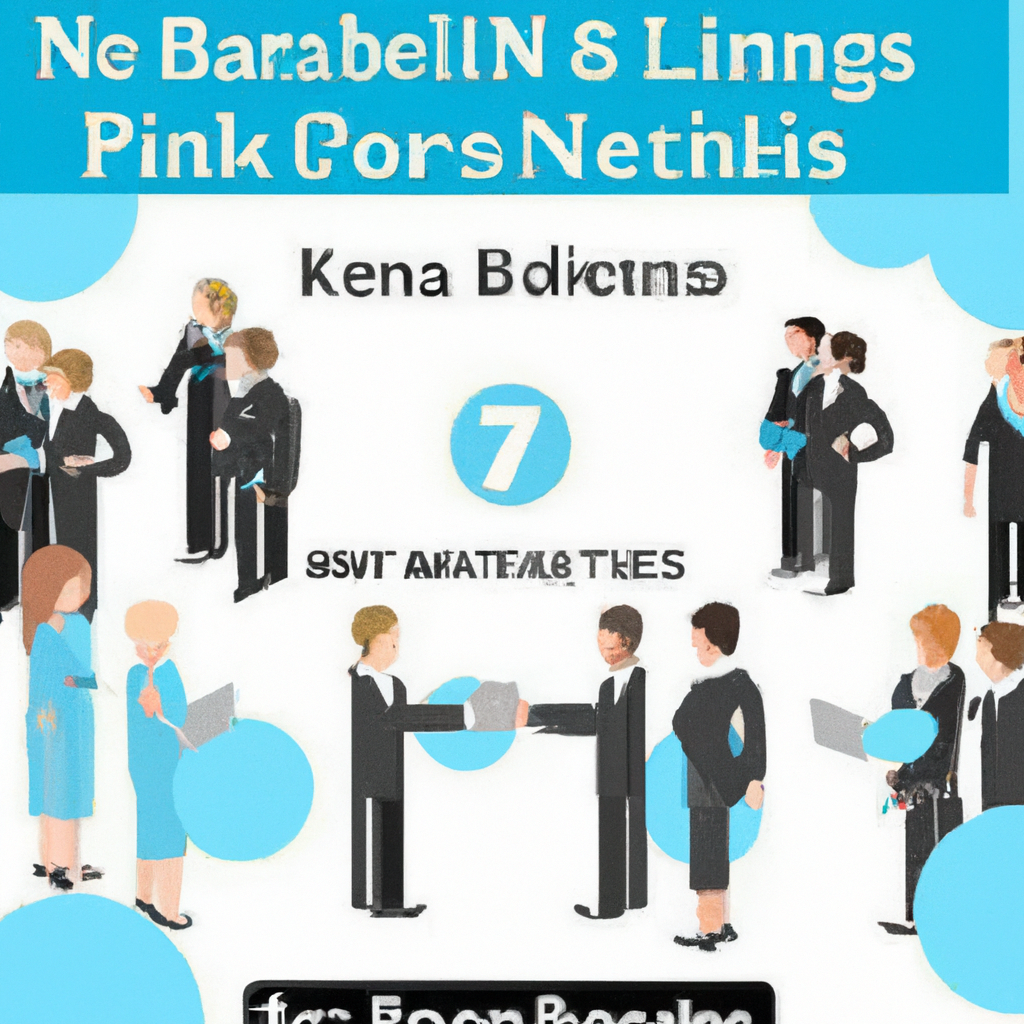LinkedIn is a powerful platform that offers immense opportunities for B2B sales and networking. In this article, discover the secrets to effectively utilize LinkedIn to boost your business and forge valuable connections. With the right strategies and techniques, you’ll learn how to leverage LinkedIn’s vast network of professionals to drive sales and enhance your professional network. Get ready to unlock the full potential of LinkedIn and take your B2B sales and networking to new heights!
Creating an Effective LinkedIn Profile
Choosing the Right Profile Picture
When it comes to creating an effective LinkedIn profile, choosing the right profile picture is crucial. Your profile picture is the first impression that potential connections and employers will have of you, so it’s important to make it a good one. Choose a professional-looking headshot where you are dressed appropriately for your industry. Make sure your face is clear and visible, and that the photo is of high quality. A friendly smile can go a long way in making a positive impression.
Writing an Engaging Headline
Your headline is one of the first things people see when they visit your LinkedIn profile, so it’s important to make it attention-grabbing and engaging. Rather than simply listing your job title, use this space to showcase your value and what sets you apart. Think about the problems you solve or the expertise you bring to the table. For example, instead of “Sales Manager,” you could write “Experienced Sales Manager Driving Revenue Growth through Strategic Partnerships.”
Crafting a Compelling Summary
Your LinkedIn summary is an opportunity to give a brief overview of your professional background, experience, and skills. It should be concise, yet engaging, and should grab the reader’s attention. Use this space to highlight your key achievements and career highlights, and to showcase your unique skills and expertise that are relevant to your industry. Include keywords that are commonly used in your field to make it easier for potential connections and employers to find you.
Highlighting Relevant Experience and Skills
When it comes to showcasing your experience and skills, make sure to focus on the ones that are most relevant to your professional goals. List your previous positions, highlighting key responsibilities and accomplishments. Use bullet points to make it easy to read and scan. Additionally, make sure to list any certifications, trainings, or relevant skills that showcase your expertise. This will not only help you stand out from the competition but also make it easier for potential connections and employers to gauge your qualifications.
Including Contact Information and Social Links
To make it easier for others to get in touch with you, it’s important to include your contact information on your LinkedIn profile. Include your professional email address, phone number, and any other relevant contact details. Additionally, make sure to list links to your other social media profiles and websites, such as your company’s website or your personal blog. This will provide others with additional ways to connect with you and learn more about your professional background and interests.
Building a Strong Network on LinkedIn
Connecting with Colleagues and Current Clients
One of the first steps to building a strong network on LinkedIn is to connect with your colleagues and current clients. By connecting with people you already have a professional relationship with, you can quickly expand your network and start building meaningful connections. Reach out to your colleagues and clients and send them personalized connection requests, reminding them of your past work together and expressing your desire to stay connected.
Finding and Joining Industry-Specific Groups
LinkedIn groups are a great way to connect with like-minded professionals in your industry and build your network. Search for industry-specific groups that align with your interests and professional goals, and join the ones that resonate with you. Once you’re a member, actively engage in discussions, share insights, and answer questions to make yourself known within the group. This will not only help you expand your network but also establish yourself as a thought leader in your field.
Following Influencers and Thought Leaders
To stay updated on the latest industry trends and gain insights from experts, consider following influencers and thought leaders on LinkedIn. These individuals often share valuable content and thought-provoking ideas that can help you grow both personally and professionally. By engaging with their content and leaving thoughtful comments, you can start building relationships with these influencers and potentially expand your network through their connections.
Expanding Your Network through Alumni and School Connections
Another effective way to build your LinkedIn network is by connecting with alumni and school connections. Reach out to former classmates, professors, and alumni from your alma mater and send them personalized connection requests. Alumni networks can be highly valuable in terms of professional opportunities and networking, so don’t hesitate to leverage these connections. You never know who might be able to provide valuable insights or even open doors to new career opportunities.
Attending LinkedIn Events and Meetups
LinkedIn offers a range of virtual and in-person events, such as webinars, conferences, and meetups, that are designed to facilitate networking and professional development. Take advantage of these events to connect with industry professionals, learn from experts, and expand your network. Participate actively in discussions, ask questions, and follow up with those you meet to nurture your connections. Attending LinkedIn events can be a great way to build relationships and discover new opportunities within your industry.

Using LinkedIn for B2B Sales
Leveraging Advanced Search Features to Find Prospects
One of the key features of LinkedIn for B2B sales is its advanced search capabilities. Utilize the search filters to narrow down your search and find prospects that fit your target audience. You can filter by location, industry, job title, company size, and much more. Take the time to define your ideal customer profile and use the search features to identify potential leads that align with your criteria. This will help you focus your efforts on the most promising opportunities.
Sending Personalized Connection Requests and Messages
When reaching out to prospects on LinkedIn, it’s important to personalize your connection requests and messages. Avoid generic and automated messages, as they are less likely to grab the recipient’s attention. Instead, tailor your messages to each individual, highlighting why you are reaching out and how you believe you can provide value to them. Personalization shows that you have taken the time to research and understand their needs, increasing the likelihood of a positive response.
Engaging with Targeted Content and Posts
In order to build rapport and establish yourself as a thought leader in your field, make it a point to engage with targeted content and posts on LinkedIn. Like and comment on posts that are relevant to your industry and offer valuable insights or ask thought-provoking questions. This will not only increase your visibility but also demonstrate your expertise and interest in the topics being discussed. Engaging with others’ content can also lead to meaningful conversations and potential opportunities.
Utilizing Sales Navigator and Advanced Analytics
LinkedIn’s Sales Navigator is a powerful tool for B2B sales professionals. It provides advanced search capabilities, lead recommendations, and real-time sales updates. With Sales Navigator, you can save leads and accounts, receive notifications about job changes and company updates, and track engagement with your content. Additionally, LinkedIn’s advanced analytics provide valuable insights into the performance of your sales activities, allowing you to optimize your strategies and improve your results.
Leveraging Recommendations and Endorsements
Recommendations and endorsements from clients, colleagues, and business partners can significantly enhance your credibility and reputation on LinkedIn. Reach out to satisfied clients and ask them to write a recommendation for your services or endorse your skills. These endorsements and recommendations serve as social proof and can help build trust with potential clients. Make sure to reciprocate the gesture and write recommendations for those who have provided you with exceptional service or support, as this will further strengthen your professional relationships.
Creating and Sharing Compelling Content
Understanding Your Target Audience and Their Pain Points
To create and share compelling content on LinkedIn, it’s essential to understand your target audience and their pain points. Consider the challenges and problems that your audience faces and develop content that offers solutions or valuable insights. Conduct research, listen to your audience’s feedback, and stay up to date with industry trends to ensure that your content is timely and relevant.
Developing a Content Strategy and Editorial Calendar
A well-planned content strategy and editorial calendar can help you stay organized and consistent in your content creation and sharing efforts. Start by defining your goals and objectives for your content, whether it’s to inform, educate, or entertain your audience. Then, outline the topics you want to cover and map out a schedule for publishing your content. This will help you maintain a regular cadence of content creation and ensure that your audience is consistently engaged.
Writing Compelling Articles and Posts
When writing articles and posts on LinkedIn, it’s important to grab the reader’s attention right from the start. Craft compelling headlines and opening paragraphs that entice the reader to continue reading. Use storytelling techniques, data, or personal anecdotes to make your content relatable and engaging. Break up your content into shorter paragraphs and use bullet points or numbered lists to make it easier to read and digest. Don’t forget to include a clear call-to-action at the end of your content to encourage further engagement.
Using Visuals and Videos to Enhance Engagement
Visual content, such as images and videos, can significantly enhance engagement on LinkedIn. Include eye-catching visuals in your articles and posts to grab the reader’s attention and make your content more visually appealing. Consider creating short videos that provide valuable insights or demonstrations related to your industry. Visuals and videos not only make your content more engaging but also make it more shareable, increasing its reach and potential impact.
Sharing and Promoting Your Content across Relevant Channels
Once you’ve created compelling content, it’s important to share and promote it across relevant channels. In addition to publishing your content on LinkedIn, consider sharing it on your other social media platforms, such as Twitter, Facebook, and Instagram. If you have a blog or website, embed your LinkedIn articles or posts there as well. By promoting your content across different channels, you can expand your reach and increase the chances of it being seen and shared by a wider audience.

Utilizing LinkedIn Groups and Communities
Joining and Participating in Relevant Groups
LinkedIn groups provide a valuable opportunity to connect with professionals in your industry and exchange insights and ideas. Joining relevant groups can help you expand your network, learn from others, and stay up to date with the latest industry trends. Search for groups that align with your interests and professional goals, and join the ones that resonate with you. Once you’re a member, actively participate in discussions, share your expertise, and engage with other group members to build meaningful relationships.
Providing Value through Thoughtful Comments and Discussions
Actively engage in discussions within LinkedIn groups by providing value through thoughtful comments and insights. Take the time to read and understand the content being discussed before sharing your thoughts. Ask questions, offer solutions, and share relevant experiences to contribute to the conversation. By providing thoughtful and valuable input, you can establish yourself as a trusted and knowledgeable professional within the group.
Showcasing Expertise through Answering Questions and Sharing Insights
LinkedIn groups often have members who are seeking answers and insights related to their industry or professional challenges. Take the opportunity to showcase your expertise by answering questions and providing valuable insights. Share your knowledge, experiences, and best practices to help others in the group find solutions to their problems. By positioning yourself as a valuable resource, you can attract attention and build relationships with potential clients or partners.
Starting Engaging Conversations and Polls
Engaging conversations and polls can help spark meaningful interactions within LinkedIn groups. Start conversations on topics that are relevant to the group’s interests or share polls to gather opinions and insights. Encourage group members to share their thoughts and experiences, and actively participate in the discussions that follow. Engaging conversations and polls not only foster collaboration but also provide opportunities to network and build relationships with other group members.
Building Relationships with Group Members
Building relationships with other group members is one of the primary goals of participating in LinkedIn groups. Start by reaching out to individuals who have shared similar interests or have provided valuable insights within the group. Send personalized connection requests, mentioning the group and your shared interests as common ground for networking. Foster these relationships by engaging with their content, sharing their insights, and offering support when needed. Cultivating relationships within LinkedIn groups can lead to fruitful partnerships and collaborations in the future.
Engaging with LinkedIn’s Sales and Marketing Tools
Exploring LinkedIn Sales Navigator and Its Features
LinkedIn Sales Navigator is a powerful tool that provides sales professionals with advanced search capabilities, lead recommendations, and real-time updates. Take the time to explore its features and functionalities to understand how it can support your sales efforts. Utilize the advanced search filters to identify potential leads, save leads and accounts for future reference, and track engagement with your content. By leveraging Sales Navigator, you can streamline your prospecting process and focus your efforts on the most promising opportunities.
Understanding LinkedIn Advertising and Sponsored Content
LinkedIn offers a range of advertising options to help businesses reach their target audience and generate leads. Familiarize yourself with the different types of LinkedIn advertising, such as sponsored content, text ads, and dynamic ads. Determine the advertising format that aligns with your goals and budget, and create compelling ad campaigns that resonate with your target audience. LinkedIn’s advertising platform provides robust targeting options, allowing you to reach specific demographics, industries, or job titles.
Using LinkedIn’s Advanced Analytics and Insights
LinkedIn provides advanced analytics and insights to help you monitor the performance of your sales and marketing efforts. Take advantage of these analytics to gain valuable insights into the engagement and reach of your content, as well as the effectiveness of your campaigns. Monitor key performance metrics, such as views, clicks, and engagement rates, to determine what content and strategies are resonating with your audience. Utilize these insights to optimize your sales and marketing strategies and improve your results over time.
Integrating Sales and Marketing Efforts through LinkedIn
LinkedIn provides a unique opportunity to integrate your sales and marketing efforts to create a cohesive and impactful strategy. Work closely with your marketing team to align your messaging, targeting, and content creation. Leverage the insights and analytics provided by LinkedIn to inform your marketing efforts and ensure that your sales and marketing activities are aligned and supporting each other. By integrating your sales and marketing efforts on LinkedIn, you can create a unified approach that maximizes your reach and impact.
Optimizing Your LinkedIn Activity and Engagement
Posting and Interacting Consistently with Your Network
Consistency plays a crucial role in maintaining an active and engaged presence on LinkedIn. Make it a point to post regularly and interact with your network consistently. Share industry insights, helpful resources, or updates about your own work to provide value to your connections. Engage with others’ content by liking, commenting, and sharing it to foster meaningful relationships. By consistently posting and interacting, you can demonstrate your expertise and stay top of mind with your network.
Engaging in Meaningful Conversations and Discussions
LinkedIn is not just a platform for broadcasting your own thoughts and content; it’s also a place for meaningful conversations and discussions. Engage in discussions related to your industry, share your insights, and ask thoughtful questions. Listen actively and respond genuinely to others’ perspectives. By actively participating in conversations, you can build relationships, expand your network, and establish yourself as a trusted voice within your industry.
Taking Advantage of LinkedIn’s Hashtags and Trending Topics
Hashtags can help increase the visibility of your content on LinkedIn and attract a wider audience. Research industry-specific hashtags and trending topics related to your field and incorporate them into your posts. By using relevant hashtags, you can make it easier for others to discover and engage with your content. Additionally, keep an eye on trending topics and join the discussions when appropriate. This will help you stay up to date with the latest industry conversations and increase your visibility.
Monitoring and Responding to Comments and Messages
When engaging on LinkedIn, it’s important to monitor and respond to comments and messages in a timely manner. Acknowledge and respond to comments on your posts, thanking people for their insights or answering their questions. Respond promptly to messages from potential connections, clients, or collaborators to maintain a professional and attentive presence. By actively engaging and providing timely responses, you can build stronger connections and leave a positive impression on others.
Tracking and Measuring Your LinkedIn Performance
To gauge the effectiveness of your LinkedIn activities, it’s important to track and measure your performance. Monitor key metrics such as post views, engagement rates, and connection growth to determine what strategies are working and what needs improvement. LinkedIn provides analytics and insights that can help you understand the impact and reach of your activities. Regularly review and analyze these metrics to optimize your LinkedIn strategy and achieve your sales and networking goals.
Nurturing and Converting Leads on LinkedIn
Building Rapport and Trust with Prospects
Building rapport and trust with your LinkedIn leads is essential for successful lead nurturing and conversion. Take the time to understand their needs and pain points, and personalize your interactions accordingly. Provide value through helpful insights, resources, or recommendations to establish yourself as a trusted advisor. Take a genuine interest in their success and actively listen to their concerns. By building rapport and trust, you increase the likelihood of converting leads into loyal clients.
Nurturing Relationships through Personalized Messages
As you nurture your LinkedIn leads, personalized messages can go a long way in fostering relationships. Use the information you have gathered about your leads to tailor your messages and offer relevant solutions or insights. Demonstrate that you understand their challenges and have their best interests in mind. Avoid generic sales pitches and focus on building a connection based on mutual value and trust. Regularly engage with your leads through personalized messages to maintain the relationship over time.
Utilizing LinkedIn’s InMail and Sponsored InMails
LinkedIn’s InMail and Sponsored InMails offer an effective way to reach out to leads and stay top of mind. InMail allows you to send personalized messages to any LinkedIn member, even those who are not in your network. Sponsored InMails, on the other hand, provide a way to reach a broader audience with your messages. Utilize these features strategically to nurture leads, share valuable content, and drive conversions. However, make sure to personalize your messages and keep them relevant to the recipient to maximize their impact.
Moving Leads through the Sales Funnel with Targeted Content
Utilize targeted content to move your leads through the sales funnel on LinkedIn. Create content such as blog posts, case studies, or whitepapers that address your leads’ pain points and provide valuable solutions. Share this content with your leads to guide them towards a purchase decision. By demonstrating your expertise and the value of your product or service, you can nurture your leads and increase the chances of conversion. Track the engagement and interactions with your content to identify warm leads and tailor your strategies accordingly.
Measuring and Optimizing Lead Conversion on LinkedIn
Measuring and optimizing lead conversion on LinkedIn is crucial for refining and improving your sales efforts. Track the progress of leads through the sales funnel and measure the conversion rates at each stage. Analyze which strategies, messages, or content are most effective in converting leads into customers. Use this information to fine-tune your approach and optimize your lead conversion process. Continuously measure and analyze your results to identify areas for improvement and refine your LinkedIn sales strategy over time.
Leveraging LinkedIn Analytics and Insights
Understanding LinkedIn’s Analytics Dashboard
LinkedIn provides a comprehensive analytics dashboard that offers insights into the performance of your profile, content, and engagement. The analytics dashboard gives you information on audience demographics, profile views, engagement rates, and post performance. Take the time to familiarize yourself with the different metrics and understand what they mean for your LinkedIn activity and objectives. The analytics dashboard can provide valuable insights to guide your content strategy and optimize your LinkedIn presence.
Analyzing Profile and Content Performance Metrics
When analyzing your LinkedIn analytics, pay close attention to your profile and content performance metrics. Track the number of profile views, connection growth, and engagement rates to assess the effectiveness of your profile and content. Additionally, analyze the performance of individual posts or articles to understand what type of content resonates most with your audience. By regularly reviewing these metrics, you can identify trends and patterns that can help you refine your content strategy and improve your overall LinkedIn presence.
Identifying Trends and Patterns in Engagement
LinkedIn analytics can help you identify trends and patterns in engagement with your content. Consider the days and times when your posts receive the most views, comments, and shares. Look for patterns in the types of content that generate the most engagement. Analyze the topics or formats that consistently perform well and resonate with your audience. By understanding these trends and patterns, you can optimize your content creation and sharing efforts to maximize engagement and reach on LinkedIn.
Utilizing Insights for Content Strategy Optimization
The insights provided by LinkedIn analytics are a valuable resource for optimizing your content strategy. Use the data to refine your content topics, formats, and posting schedule. Tailor your content strategy to align with the preferences and behaviors of your audience. Experiment with different types of content and analyze the results to determine what works best. Continuously optimizing your content strategy based on LinkedIn insights will help you maintain strong engagement and drive results on the platform.
Improving Personal and Company Branding
LinkedIn analytics can also provide insights into the impact of your personal and company branding efforts. By analyzing your profile and content performance metrics, you can assess the effectiveness of your personal and company branding strategies. Take note of audience demographics, reach, and engagement to determine if your message is resonating with your target audience. Use this information to refine your branding efforts and improve your personal and company branding on LinkedIn.
Building Personal and Professional Brand on LinkedIn
Optimizing Your Profile for Search Engine Visibility
Optimizing your LinkedIn profile for search engine visibility is essential for building your personal and professional brand. Use relevant keywords and phrases throughout your profile, including in your headline, summary, experience section, and skills. This will help your profile appear in search results when people are looking for professionals in your field. Additionally, make sure to complete all sections of your profile and keep it up to date with your latest accomplishments and experiences.
Sharing Thought Leadership Content and Insights
Building your personal brand on LinkedIn involves sharing thought leadership content and insights. Write articles or posts that offer valuable insights, tips, or solutions related to your industry or area of expertise. Provide unique perspectives and showcase your knowledge and expertise in your field. Share your thoughts and opinions on relevant industry trends or news. By consistently sharing thought leadership content, you can establish yourself as a trusted authority and attract a loyal following.
Participating in LinkedIn’s Pulse Publishing Platform
LinkedIn’s Pulse publishing platform provides an opportunity to showcase your expertise in a dedicated space. Consider publishing articles directly on LinkedIn to reach a wider audience and gain visibility as an industry expert. Use this platform to share in-depth content, thought leadership pieces, or case studies that highlight your capabilities. Leverage the Pulse publishing platform to demonstrate your expertise and position yourself as a go-to resource for industry insights.
Building and Demonstrating Expertise through Recommendations and Endorsements
Recommendations and endorsements from clients, colleagues, and business partners can significantly enhance your personal and professional brand on LinkedIn. Request recommendations from satisfied clients or colleagues who can speak to your expertise and professionalism. Similarly, endorse the skills of others in your network, as this can lead to reciprocal endorsements. By building and demonstrating your expertise through recommendations and endorsements, you can strengthen your personal brand and attract opportunities for growth.
Leveraging LinkedIn for Personal Branding and Job Opportunities
LinkedIn is not only a powerful platform for personal branding but also a valuable resource for job opportunities. Make sure that your LinkedIn profile accurately reflects your professional achievements, skills, and experiences. Leverage the platform’s job search functionality and engage with job-related content and discussions. Network with professionals in your field and express your career aspirations. By actively leveraging LinkedIn for personal branding, you increase your visibility and open doors to new job opportunities.




